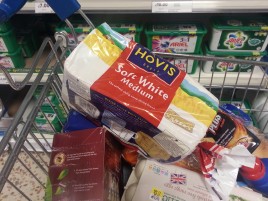Transcript
When we think of the stuff that dreams are made on, we might think of the spirits that Shakespeare’s Prospero conjures up in “The Tempest”; we might think of stars, rainbows, maybe even wishing wells, but what probably doesn’t leap to mind is a loaf of Wonder Bread. And yet, ever since the invention of the mass-manufactured loaf of white bread in the 1920s, that spongy tasteless loaf has been a way in which Americans have defined themselves and one another.
This podcast was made for the New Books Network, on their New Books on Food strand. In it Eric LeMay talks to Aaron Bobrow-Strain, from Whitman College.
In his new book, White Bread: A Social History of the Store-Bought Loaf (Beacon Press, 2012), Aaron Bobrow-Strain shows us how that familiar slice of white bread is much more than a food. It’s a symbol, one that in its nearly hundred-year-old existence has come to represent “the apex of modern progress and the specter of physical decay, the promise of a better future to come and America’s fall from small-town agrarian virtue.”
The history Bobrow-Strain tells us ranges from the immigrant bakeries of turn-of-the-century America to the Cold War to the rise of yuppie and “locavore” eating habits. It’s a history, as he writes, “of the countless social reformers, food experts, industry executives, government officials, diet gurus, and ordinary eaters who have thought that getting Americans to eat the right bread (or avoid the wrong bread) could save the world—or at least restore the country’s moral, physical, and social fabric.


Subscribe with…